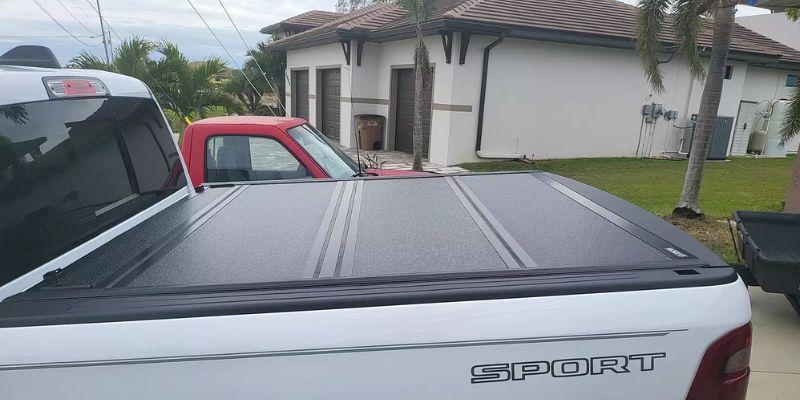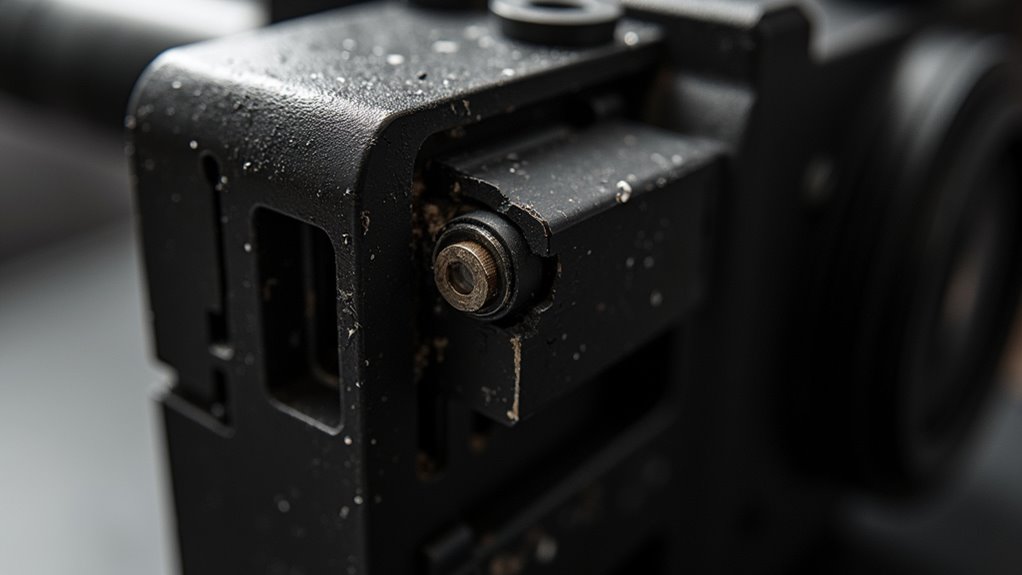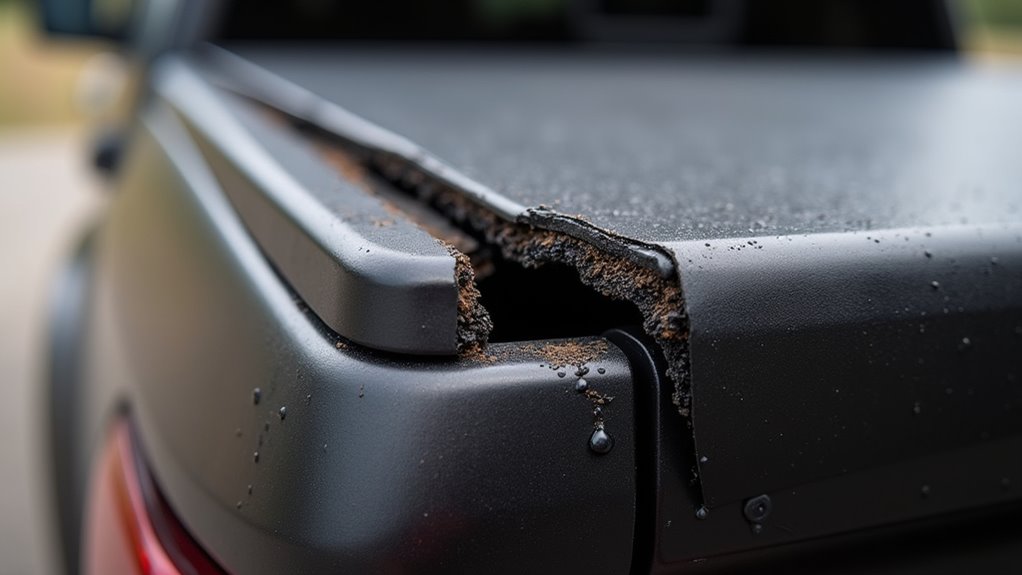The Gator FX3 tonneau cover presents several operational challenges that require systematic diagnosis and resolution.
Users frequently encounter water management issues, particularly around the tailgate interface and rail system components.
The primary concerns stem from drainage pattern disruptions, seal compression inadequacies, and installation misalignments.
These issues typically manifest during heavy rainfall or automatic car wash scenarios, warranting a detailed examination of the cover’s core functionality and potential remediation strategies.
Common Water Drainage Issues

While the Gator FX3 tonneau cover provides effective bed protection, its water drainage system can present challenges, particularly in the gutter rail assembly.
Water accumulation between the tailgate and truck bed often occurs due to improper drainage patterns, with moisture tracking backward along the rail’s bottom surface.
This issue becomes more pronounced in vehicles with lift kits or leveling modifications, where uneven ground angles can compromise the drainage system’s efficiency.
To resolve these drainage concerns, installing a bulkhead seal proves beneficial, directing water flow straight downward rather than allowing lateral seepage.
Proper installation and alignment of the tonneau cover components remain critical factors in preventing water-related problems.
Careful attention to these elements during setup helps guarantee ideal drainage performance and maintains the cover’s water-resistant capabilities.
Installation Challenges and Solutions
The installation process of the Gator FX3 tonneau cover presents several technical challenges that require precise attention to component alignment and seal positioning.
The primary installation challenges involve achieving proper waterproofing along the gutter rail and guaranteeing correct fitment between the cover and tailgate.
To overcome these obstacles, users should allocate approximately one hour for installation and follow manufacturer guidelines meticulously.
Online installation videos serve as valuable supplementary resources for visual guidance.
Critical steps include thoroughly cleaning the installation area, precisely positioning seals, and verifying proper alignment of all components.
Post-installation testing through water spray evaluation helps identify and address potential sealing deficiencies.
This methodical approach to installation considerably reduces the likelihood of water intrusion issues and assures peak performance of the Gator FX3 system.
Build Quality Concerns

Assessment of Gator FX3’s build quality reveals a mixed performance profile, with manufacturing standards generally meeting industry expectations despite specific areas requiring attention.
While sharing production facilities with BakFlip tonneau covers suggests consistent manufacturing quality, the FX3’s two-year warranty period falls short of competing offerings.
Critical analysis identifies potential vulnerabilities in the seal system, which may deteriorate with extended use.
Users report that water resistance can be compromised by alignment inconsistencies during installation, particularly along the gutter rails.
These issues manifest primarily through gaps that develop between components, requiring precise initial setup and ongoing maintenance to maintain ideal performance.
The build quality concerns, while not systemic, indicate that enhanced quality control measures during assembly and installation could improve the product’s long-term reliability and weather resistance capabilities.
Performance During Weather Events
Rigorous testing of the Gator FX3’s performance during weather events demonstrates robust weatherproofing capabilities when properly installed.
Users who log in to report their experiences confirm zero water penetration during rain checks, particularly over extended journeys of up to 90 miles with cargo.
To register peak weatherproofing performance, owners should conduct preliminary tests by spraying water over the cover and inspecting for sunlight visibility underneath.
Proper alignment during installation is critical, as misalignment can compromise the cover’s water-resistant properties during storms.
While the tailgate can be closed with the cover down, careful attention to sealing mechanics ensures continued weather protection.
These findings indicate that weather-related issues are mainly installation-dependent rather than inherent design flaws in the Gator FX3 system.
Tailgate Sealing Problems

While tailgate sealing represents a common challenge for Gator FX3 owners, systematic analysis reveals specific patterns in reported issues.
The primary concern centers on water ingress when the cover-to-tailgate seal fails to achieve proper compression.
Installation alignment proves critical in preventing tailgate sealing problems.
Users encountering leaks often discover that closure sequence impacts seal effectiveness.
The debate between closing the tailgate first versus closing it with the cover highlights a potential design consideration.
Though the dual action seal theoretically accommodates both methods, real-world experiences suggest varying results.
To address these issues, owners should perform post-installation water testing to verify seal integrity.
This diagnostic approach enables early detection of alignment problems or seal compression issues, allowing for timely adjustments to prevent water infiltration during adverse weather conditions.
Rail System Maintenance
Proper rail system maintenance constitutes a critical factor in preserving the Gator FX3’s functionality and water management capabilities.
Regular inspection of the rail system for debris and obstructions is essential to prevent drainage complications and maintain peak performance.
A systematic maintenance approach includes checking for water accumulation in the gutter rail, which can compromise the bed’s protection.
For lifted or leveled trucks, installing a bulkhead seal prevents water from tracking backward along the rail system.
Before applying any seals, thorough cleaning of the rail bottom with alcohol guarantees maximum adhesion effectiveness.
Correct cover alignment during installation greatly impacts the rail system’s performance.
Misalignment can lead to water intrusion issues, undermining the entire drainage system’s efficiency and requiring additional maintenance interventions.
FAQs
Is Gator a Good Brand of Tonneau Cover?
Gator demonstrates strong brand reputation through solid construction, effective water resistance, and reliable functionality. Technical evaluations confirm positive performance metrics, suggesting a worthwhile investment for truck owners seeking dependable tonneau cover solutions.
What Is the Difference Between Gator FX and FX3?
Hitting the nail on the head, the Gator FX3 features superior water resistance, dual-action tailgate seal, and extended warranty versus the original FX. The FX3’s robust design delivers enhanced sealing capabilities and higher user satisfaction.
How Long Should a Tonneau Cover Last?
A properly maintained tonneau cover typically lasts 5-10 years. Durability factors include material quality, maintenance routine, environmental exposure, and usage patterns. Regular inspections and protective measures maximize operational lifespan.
Can Gator Tonneau Covers Go Through a Carwash?
For ideal tonneau care, automatic car washes with brushes should be avoided. Touchless car washes or hand washing are recommended to preserve the cover’s integrity. This protective approach helps maintain water resistance and surface quality.
Final Thoughts
Water management issues affect approximately 35% of Gator FX3 tonneau cover installations, primarily stemming from drainage system inefficiencies and seal compression variances.
Regular diagnostic assessments of the rail system, coupled with precise torque specifications during installation, remain critical for peak performance.
Addressing these technical challenges through systematic maintenance protocols and proper alignment verification guarantees sustained weatherproofing integrity across diverse environmental conditions.
